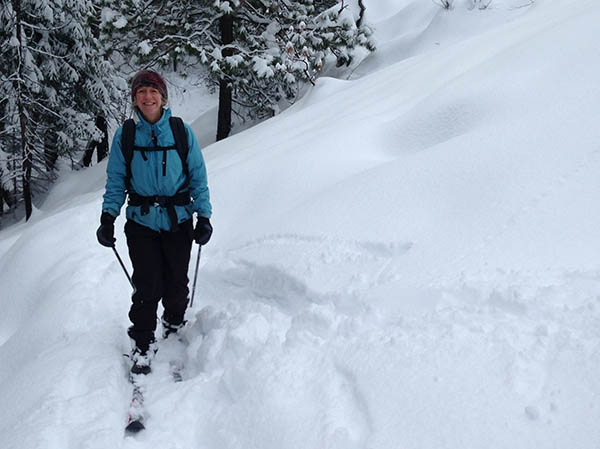Friends try not to stare, but they can’t help it. Stop with them at the garage to pick up some motor oil or lag screws, floaty toys in summer or cider jars in fall, and they stop cold in their tracks. You did not seem so obsessive, like a hoarder, like those addle-eyed freaks on TV. But it’s hard not to notice. The paint cans, the fire pump, the rubber boots, the broke-down saws all turn, apparently, invisible.
Skis are all they see.
Our garage sits along a road to nowhere, a road that runs from the Stehekin boat landing at the head of Lake Chelan, and goes for twelve miles where it dead-ends in wilderness. Cars arrive by barge and stay until they die, and well-beyond. Our little landlocked town, tucked in the North Cascades, is like an island, but it’s not an island; one of the least-island-like aspects, and definitely the best, is snow. We get ten feet annually but wish for more. Summer can be frenetic—seasonal jobs and tourists, lake-play and wildfires, long hikes and houseguests—but winter is all silence and magic. Hence the skis.
Skis tucked in cinder blocks. Skis leaning on stovepipe. Skis hanging, properly, from a ceiling rack scabbed together with rough-cut lumber scraps. Skis with spiders. Skis with dust. Skis with bindings that look like paper clips and hold like a vice, bindings that were only available for two seasons in the mid-1980s, which have lasted against all odds. Side-cut skis that don’t edge on ice. Straight long skis that slide fast in slush and turn poorly in slop, though god knows you tried. For years, for decades.

“Which ones do you use?” your friends ask.
“All of them,” you say.
Then they know they are in for it: the stories. Skis you stuck like a cage into the crust to keep your garbage-bag bivvy from sliding down the ridge on the night you skipped sleep to watch the moon skirt ridge tops like a skiff. Skis you held like swords to fight off coyotes encircling the tent.
You can’t show your friends the ones that didn’t make it. Not the skis you wore when you fell six miles up Devore Creek and had to limp out—those, like your ligament, are long gone—but yes, here are the ones you wore after surgery, inching back, sliding through hoar frost tinkling like glass, tentative but stubborn. Stubborn, too, on the lifts in your leather, in your three pins, shrugging off the sneers on downlake trips to Mission Ridge or Stevens, splitting a half-day pass and switching jackets after each run, eating jerky from the pocket of your anorak with the dirty Kleenex and the slushy cans of Pabst or Rainier.
Check out this used rental pair you got for twenty bucks: poles, boots, and all. The boards are paint-peeled and scratched to hell. The boots offer as much ankle support as a heavy wool sock. You wear them every single Tuesday, No Whining Day, to slog with friends up this same road to nowhere. If it rains we ski. If it’s wicked cold, we ski. If the snow sticks to the bottom of our skis thick as sheet cake, we stop to scrape with a pocketknife or a mitten, or rub the waxless scales with a votive candle, or spray them with Pam or silicone. The weather doesn’t matter, the conditions don’t matter. The snow-cloaked forest offers comfort and wonder. Once we saw a wolverine; often we see elk. Plus snowshoe hares and raptors, tiny fragile tracks of mice.
There’s more! Skis that delaminated in the woods. Bindings re-drilled and epoxied until screw holes grew wide as dimes, then nickels, until wood puddled to rot. The tool kit with steel wool and zip ties, screwdriver and wood screws, matchsticks, duct tape, candles, wax.
Oh, and this! Wrapped with baling twine, multi-colored, with an expandable post, faded a bit but not frayed or torn: a beach umbrella! We salvaged it at the local dump and stash it now on a snowy hump that faces the sun in January where we’ll stomp down a place to sit and share snacks: homemade pizza and elaborate wraps, cilantro pesto, canned oysters, and dried fruit, the rarer the better. Apples always, watermelon just once.
You show them the snowshoes you use to take kids to the gravel pit to sled, the ones you used to carry for emergencies, like the time you got lost on a trail you’d skied a thousand times before and ended up in a canyon bottom and had to climb back up and …
Why don’t you carry them anymore?
You shrug.
Because we love skis.
You gaze around dreamily. You know that it is time to leave this musty hole. Get on with life. But you’re not ready; you’re not even really in the garage anymore; you’re thinking ahead to the day when you’ll haul them out, one pair at a time, and not put them back. By mid-winter, they’ll be stacked on the porch, strewn in the woodshed, stuck in the shed-side berm, the full selection in full view, in case you have to decide fast before dark to head out in blue jeans with no cap into the dusk, onto the snow, because what else is there to do?
Just slide. // (Ana Maria Spagna)
Ana Maria Spagna has lived and skied in Stehekin, Washington for the past 25 years. She is the author of several books including most recently “Uplake: Restless Essays of Coming and Going,” and she wrote about working on a trail crew for the June 2005 issue of Out There.












